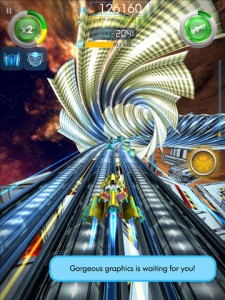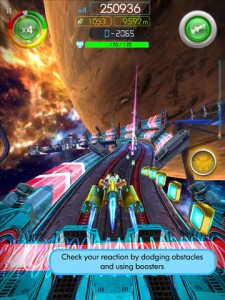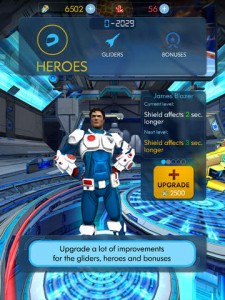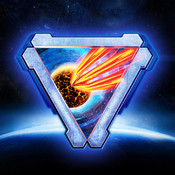Sometime in the future there is a big corporation — of probable evilness — that people didn’t like at all, and it was to this end that the “Earth Alliance” hatched a plan of retaliation. Obviously if they drove futuristic hover cars, known as Gliders, across tracks filled with trippy visuals — that were more distracting than anything else — then they might be able to do something about the tyranny if they shot their “Big Bob Gun” a few times. Or at least that’s what I think is going on in Wonderwood Games’ Glidefire (out now, free), because the game’s over all lack of explanations — coupled with a very stilted translation — doesn’t exactly try to make sense of anything.
 I’m going to get this out of the way right now, this review — other than the game’s graphics, and even those will feature some complaints as well — isn’t going to be particularly positive in nature. In fact, the first problem you will experience with Glidefire is that the game can crash while starting up — a problem many other users have also reported — and even required a full OS reboot before it started working for me at all. So — with that in mind — let’s begin delving properly into all that makes Glidefire tick, and why — as things currently stand — I really can’t recommend that anyone makes an effort to download this game right now.
I’m going to get this out of the way right now, this review — other than the game’s graphics, and even those will feature some complaints as well — isn’t going to be particularly positive in nature. In fact, the first problem you will experience with Glidefire is that the game can crash while starting up — a problem many other users have also reported — and even required a full OS reboot before it started working for me at all. So — with that in mind — let’s begin delving properly into all that makes Glidefire tick, and why — as things currently stand — I really can’t recommend that anyone makes an effort to download this game right now.
Your goal in Glidefire is to drive (glide?) your hover car down a twisting and weaving track through trippy factories and scenic outer space vistas, all while avoiding/shooting every obstacle that gets in your way. This is achieved by swiping left or right to control which of three lanes your glider is currently occupying, as well as swiping up or down to jump or duck under certain obstacles (which can sometimes also just be driven around). Also laying about each of the various tracks will be a ton of batteries that you’ll want to collect for upgrading purposes later on, as they are the most basic currency required in most any equipment enhancement.
Occasionally you will also come across barriers — or automatons — on the track that will be further marked with a red crosshair, if you tap this crosshair you will then shoot at the obstacle with your ship’s gun. Successfully destroying any of these targets will usually yield additional batteries, but can sometimes even provide you with rare research mats that will be needed alongside batteries for certain upgrades. Your gun — however — has a very limited number of blasts that can be fired, after which a lengthy cool down sequence will have to first be completed before the gun can ever hope to be utilized again.
 Also littered across each track will occasionally be a variety power-ups, that could do things such as hyper-accelerate you — launch you up to a higher track where batteries are far more common — or even enable a single use of your ship’s special “Big Bob Gun”. More power-up types will appear the farther you are into Glidefire’s story mode, which will additionally enable those specific power-up to then be upgraded so that they either last longer — or become more potent — whenever your grab them. Furthermore, access to some of these power-ups can be unlocked early if the player is willing to shell out crystals — the game’s IAP currency — rather than reaching the requisite stage milestone.
Also littered across each track will occasionally be a variety power-ups, that could do things such as hyper-accelerate you — launch you up to a higher track where batteries are far more common — or even enable a single use of your ship’s special “Big Bob Gun”. More power-up types will appear the farther you are into Glidefire’s story mode, which will additionally enable those specific power-up to then be upgraded so that they either last longer — or become more potent — whenever your grab them. Furthermore, access to some of these power-ups can be unlocked early if the player is willing to shell out crystals — the game’s IAP currency — rather than reaching the requisite stage milestone.
Also upgradable are the player’s ship and pilot, with each ship/pilot having a specific field that gets boosted each and every time the player successfully pays to increase their respective level. Furthermore, beyond the basic pilot and ship combo that all players begin with, additional pilots and crafts — each with unique focuses — can be purchased for a mixture of batteries and crystals. Players are then free to mix and match from any pilots and ships in their inventory; either by aiming to boost two separate performance aspects equally, or to select a combination that enables them to double down on one specific area.
Anyways — now that I’ve covered how the game plays in theory — it’s high time that I began covering precisely why you don’t want be playing it at all, as I previously stated I would be. The first dilemma is that Glidefire is — despite the fact that most would immediately find the game to be visually reminiscent of the WipEout series — actually a rather slow feeling experience, which makes the game’s long levels feel rather boring. The next major dilemma is that — unlike the game that Glidefire obviously wants you to compare it to — you will constantly find all of the game’s visual noise to be a big problem, leading to you endlessly ramming into obstacles you’d have otherwise easily avoided.
 It is here where Glidefire’s biggest freemium greed-tactic truly rears its ugly head, as — upon starting the game — you can only take precisely two impacts before your ship blows up and the game conveniently asks if you’d like to pay real money in order to continue. Although you can enhance your ships to have more life energy, my glider — after receiving two whole tediously grinded for upgrades — still did not yet have a large enough life bar with which to survive a second impact with any of the always hard to see scenery. Between the oppressive visual noise — the extreme corners that helped to keep obstacles out of sight until the last second — and the fact that you’d basically need to spend money to get decent upgrades any time soon, it quickly becomes clear this was all intentional.
It is here where Glidefire’s biggest freemium greed-tactic truly rears its ugly head, as — upon starting the game — you can only take precisely two impacts before your ship blows up and the game conveniently asks if you’d like to pay real money in order to continue. Although you can enhance your ships to have more life energy, my glider — after receiving two whole tediously grinded for upgrades — still did not yet have a large enough life bar with which to survive a second impact with any of the always hard to see scenery. Between the oppressive visual noise — the extreme corners that helped to keep obstacles out of sight until the last second — and the fact that you’d basically need to spend money to get decent upgrades any time soon, it quickly becomes clear this was all intentional.
I had — after a great deal of time spent with the game — only barely reached the game’s third race track; the chances of accidentally hitting two obstacles, all so that the developers could beg for more money, was just that high. I can assure you that I am anything but bad at games, instead Wonderwood has tried to ship one of those infamous iOS titles evilly made just to bore/frustrate you into wanting to pay to see the good parts. Despite the game’s claims of lucrative contests/events for those whom finish the game’s overly long story mode, as well as a special endless stage where the best players can truly test their mettle, I doubt any of it actually ever gets better based on what I’ve seen so far.
No matter how hard you try to stay on the ball to ensure that you don’t hit anything, every track has been made so long that you’re just about to fall asleep from boredom by the time you finish. Worse yet, virtually every speed booster — even though tracks are supposedly random — is guaranteed to have either an obstacle placed precisely after the point where you shield wears off, or will be followed by two hyper close obstacles — just behind a corner — so that you can’t avoid the second one when your shield gets stripped. With similar experiences happening with all of the game’s other mechanics — such as shooting itself — I was left with no choice but to accept that you were never meant to succeed legitimately in Glidefire, and thus must wholeheartedly recommend against it.
If you’re currently desperately searching for a fast paced racing game — that is both 100% free, looks amazing, and has an actual sense of speed — I would instead heavily recommend that you try SEGA’s recently released Crazy Taxi: City Rush (our review).
iFanzine Verdict: Although a very pretty game, Glidefire is a very slow feeling affair — with every stage running way too long, filled exclusively with deliberately evil visual noise — all for just one purpose: ensuring that continues are virtually always required. While we here at iFanzine have enjoyed many a freemium game before, and even appreciate the fact that every game has to successfully make money somehow, the problem here is that Glidefire’s heavily plodding action was never fun to begin with. Couple this with the fact that Glidefire has some serious issues with crashing on boot up, and there’s simply way too many other superior options — both paid and entirely free — on the market right now to even begin considering this game at the moment.


